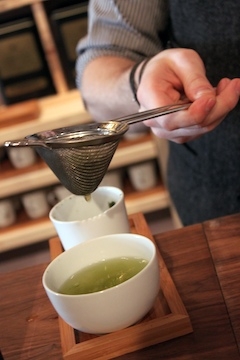How To Taste Tea Like A Pro
"Tea can be intimidating," admits Emeric Harney, general manager of the Harney & Sons store in New York City's SoHo neighborhood.
Looking at the impeccably stacked wall of black and gold tea boxes — like a tea version of the floor-to-ceiling library in Beauty and the Beast — it's easy to understand how. But after a lesson there on how to properly taste tea you quickly realize: It doesn't have to be that way.
The third-generation family company and masters of tea blending boast a repertoir of over 250 gourmet teas from China, Taiwan, Japan, India, Sri Lanka, and Africa. "Although it is becoming more chic now, there's this perception of tea as being antiquated," Emeric continues. "But it's a fabulous, interesting product with great history and stories behind it." This belief seems to be a big part of why the company has made such an effort to educate their customers — including daily tasting demonstrations at the store. Read on for a taste of what we learned.
Getting the Right Ratio
You know that familiar saying about the perfect ratio of tea to water for steeping: Use one teaspoon of tea for each cup of water, plus one for the pot? "That 'one teaspoon of tea for the pot' is an old wives' tale, you don't actually need it," says Emeric. He recommends simply using one teaspoon of tea for every six to eight ounces of water.
Time and Temperature are Key
Knowing how long and at what temperature tea needs to be steeped at is essential to a successful tasting (and enjoyable drinking experience). To demonstrate, Emeric over-steeps some green tea. "You don't want to boil it, it's going to end up tasting like burnt spinach — very bitter. This is the kind of thing that contributes to people's misconceptions about tea." Below are the steeping temperatures and lengths he recommends:
White tea: 175 degrees for three minutes
Green tea: 175 degrees for three minutes
Black tea: 208 degrees for four to five minutes
Smell the Wet Leaves
When tasting tea, Emeric stresses the importance of smelling the dry tea leaves first and then smelling the leaves again once they have steeped. "Go back and smell the wet leaves, steeping really releases the aromas."
Just breathe
As with wine, when tasting it is important to slurp and take in the tea with a little air in your mouth to get the full brunt of the flavors. But wait — there's no spitting allowed here. In fact, Emeric notes that most important in the process is to swallow the tea and then breathe out, "it helps you notice the small details and nuances in flavor."
Food Pairing
The SoHo store also houses a small café with some great bites (think outrageously good scones and tea-infused macarons) so we asked Emeric's brother and the store's food service manager, Alex, about food and tea pairings. "Tea is great at cutting through anything with oil in it, not greasy, but a food with a little oil in it," he says. He suggests oolong, Chinese black tea, and assam, a white tea, as being great for general food pairing. Other recommendations include green tea with nuts and fresh fruits, Darjeeling with dessert, and Genmaiche green tea with rice.

